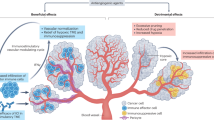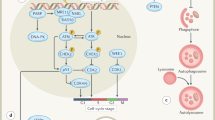Abstract
Angiogenesis, the formation of new capillaries from pre-existing vessels, is essential for tumour progression1,2,3,4,5. Angiostatin, a proteolytic fragment of plasminogen6 that was first isolated from the serum and urine of tumour-bearing mice7, inhibits angiogenesis and thereby growth of primary8 and metastatic7,9,10 tumours. Radiotherapy is important in the treatment of many human cancers, but is often unsuccessful because of tumour cell radiation resistance11,12. Here we combine radiation with angiostatin to target tumour vasculature that is genetically stable and therefore less likely to develop resistance13,14,15. The results show an antitumour interaction between ionizing radiation and angiostatin for four distinct tumour types, at doses of radiation that are used in radiotherapy. The combination produced no increase in toxicity towards normal tissue. In vitro studies show that radiation and angiostatin have combined cytotoxic effects on endothelial cells, but not tumour cells. In vivo studies show that these agents, in combination, target the tumour vasculature. Our results provide support for combining ionizing radiation with angiostatin to improve tumour eradication without increasing deleterious effects.
This is a preview of subscription content, access via your institution
Access options
Subscribe to this journal
Receive 51 print issues and online access
$199.00 per year
only $3.90 per issue
Buy this article
- Purchase on Springer Link
- Instant access to full article PDF
Prices may be subject to local taxes which are calculated during checkout




Similar content being viewed by others
References
Folkman, J. & Shing, Y. Angiogenesis. J. Biol. Chem. 267, 10931–10934 (1992).
Fidler, I. J. & Ellis, L. M. The implications of angiogenesis for the biology and therapy of cancer metastasis. Cell 79, 185–188 (1994).
Folkman, J. Angiogenesis in cancer, vascular, rheumatoid and other disease. Nature Med. 1, 27–31 (1995).
Hanahan, D. & Folkman, J. Patterns and emerging mechanisms of the angiogenic switch during tumorigenesis. J. Natl Cancer Inst. 88, 1091–1092 (1996).
Rak, J. W., St Croix, B. D. & Kerbel, R. S. Consequences of angiogenesis for tumor progression, metastasis and cancer therapy. Anticancer Drugs 6, 3–18 (1995).
Cao, Y. et al. Kringle domains of human angiostatin. Characterization of the anti-proliferative activity on endothelial cells. J. Biol. Chem. 271, 29461–29467 (1996).
O'Reilly, M. Angiostatin: a novel angiogenesis inhibitor that mediates the suppression of metastases by a Lewis lung carcinoma. Cell 79, 315–328 (1994).
O'Reilly, M., Holmgren, L., Chen, C. & Folkman, J. Angiostatin induces and sustains dormancy of human primary tumors in mice. Nature Med. 2, 689–692 (1996).
Holmgren, L., O'Reilly, M. S. & Folkman, J. Dormancy of micrometastases: balanced proliferation and apoptosis in the presence of angiogenesis suppression. Nature Med. 1, 149–153 (1995).
Sim, B. K. et al. Arecombinant human angiostatin protein inhibits experimental primary and metastatic cancer. Cancer Res. 57, 1329–1334 (1997).
Weichselbaum, R. R. et al. Radiation-resistant and repair-proficient human tumor cells may be associated with radiotherapy failure in head- and neck-cancer patients. Proc. Natl Acad. Sci. USA 83, 2684–2688 (1986).
Weichselbaum, R. R., Beckett, M. A., Dahlberg, W. & Dritschilo, A. Heterogeneity of radiation response of a parent human epidermoid carcinoma cell line and four clones. Int. J. Radiat. Oncol. Biol. Phys. 14, 907–912 (1988).
Kerbel, R. S. Inhibition of tumor angiogenesis as a strategy to circumvent acquired resistance to anti-cancer therapeutic agents. BioEssays 13, 31–36 (1991).
Kakeji, Y. & Teicher, B. A. Preclinical studies of the combination of angiogenic inhibitors with cytotoxic agents. Invest. New Drugs 15, 39–48 (1997).
Teicher, B. A., Sotomayor, E. A. & Huang, Z. D. Antiangiogenic agents potentiate cytotoxic cancer therapies against primary and metastatic disease. Cancer Res. 52, 6702–6704 (1992).
Gately, S. et al. The mechanism of cancer-mediated conversion of plasminogen to the angiogenesis inhibitor angiostatin. Proc. Natl Acad. Sci. USA 94, 10868–10872 (1997).
Acknowledgements
We thank S. Hellman and R. Salloum for discussions.
Author information
Authors and Affiliations
Corresponding author
Rights and permissions
About this article
Cite this article
Mauceri, H., Hanna, N., Beckett, M. et al. Combined effects of angiostatin and ionizing radiation in antitumour therapy. Nature 394, 287–291 (1998). https://doi.org/10.1038/28412
Received:
Accepted:
Issue Date:
DOI: https://doi.org/10.1038/28412
This article is cited by
-
Synthesis, spectral characterisation, in vitro cytotoxicity, antimicrobial, antioxidant, DFT and molecular docking studies of Ru(III) complexes derived from amide-based macrocyclic ligands
Research on Chemical Intermediates (2023)
-
Interfering with Tumor Hypoxia for Radiotherapy Optimization
Journal of Experimental & Clinical Cancer Research (2021)
-
Small molecules in targeted cancer therapy: advances, challenges, and future perspectives
Signal Transduction and Targeted Therapy (2021)
-
Synthesis of new benzo[f]chromene-based heterocycles targeting anti-proliferative activity
Journal of the Iranian Chemical Society (2021)
-
Harnessing the potential of multimodal radiotherapy in prostate cancer
Nature Reviews Urology (2020)
Comments
By submitting a comment you agree to abide by our Terms and Community Guidelines. If you find something abusive or that does not comply with our terms or guidelines please flag it as inappropriate.



